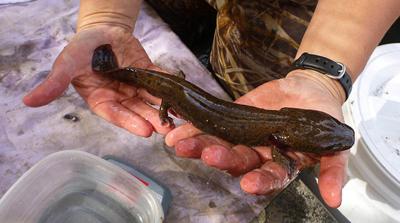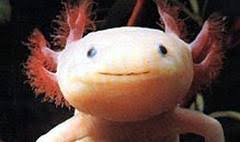Mud Puppies do turn out to be a thing, although not the beings that Sekishi was thinking about during our tea time ...


Sekishi apparently mistook them for the "Devil's Hole Pup Fish" ...

A common mistake.
Gassho, J
STLah

Size and Range
Among the largest of the salamanders, mudpuppies can exceed 16 inches in length, although the average is more like 11 inches. Their range runs from southern central Canada, through the midwestern United States, east to North Carolina and south to Georgia and Mississippi.
Habitat
Mudpuppies live on the bottoms of lakes, ponds, rivers, and streams, and never leave the water. They hide themselves in vegetation and under rocks and logs, emerging at night to feed on whatever prey they can catch, including crayfish, worms, and snails.
Unique Characteristics
Mudpuppies are easily distinguishable by their bushy, red external gills, which they grow as larva and never lose. They have flat heads, wide tails, stubby legs, and feet with four distinct toes. Their bodies are gray or brownish-gray with blue-black spots.
Among the largest of the salamanders, mudpuppies can exceed 16 inches in length, although the average is more like 11 inches. Their range runs from southern central Canada, through the midwestern United States, east to North Carolina and south to Georgia and Mississippi.
Habitat
Mudpuppies live on the bottoms of lakes, ponds, rivers, and streams, and never leave the water. They hide themselves in vegetation and under rocks and logs, emerging at night to feed on whatever prey they can catch, including crayfish, worms, and snails.
Unique Characteristics
Mudpuppies are easily distinguishable by their bushy, red external gills, which they grow as larva and never lose. They have flat heads, wide tails, stubby legs, and feet with four distinct toes. Their bodies are gray or brownish-gray with blue-black spots.

A common mistake.

Gassho, J
STLah

 Really, a lovely lead up to Ango.
Really, a lovely lead up to Ango. 



Comment